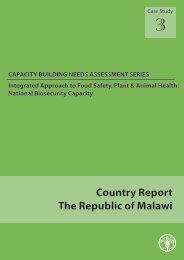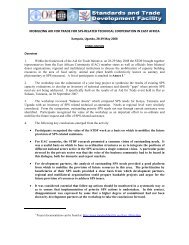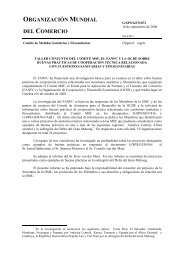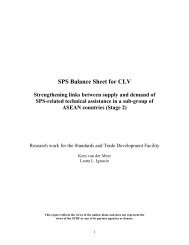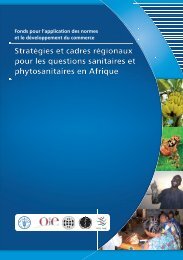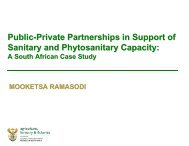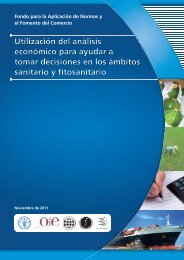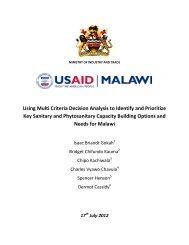Kenya - Standards and Trade Development Facility
Kenya - Standards and Trade Development Facility
Kenya - Standards and Trade Development Facility
Create successful ePaper yourself
Turn your PDF publications into a flip-book with our unique Google optimized e-Paper software.
ANNEX IIINotes to the balance sheet:The tables presents for each area of food safety, animal <strong>and</strong> plant health (sections 5-7) the current status <strong>and</strong>needs of SPS capacities (in general terms), assistance provided by donors <strong>and</strong> identified gaps with priorities.For each area, there are three sub-components: awareness, regulation <strong>and</strong> enforcement. In addition to thethree areas, there are separate parts for market access (section 4) <strong>and</strong> overall institutional capacity (section 8).The columns are explained below. The top of the table (section 1-3) is an introduction <strong>and</strong> summary of thegaps identified - including those gaps that are of most <strong>and</strong> immediate concern – <strong>and</strong> a brief note on trends indonor assistance.ColumnsStatusNeedsAssistanceGapsPrioritiesNotesThe capacities are based on existing capacity assessments <strong>and</strong> evaluations <strong>and</strong> other availablestudies (see references in Annex II) <strong>and</strong> updated in interviews with stakeholders ingovernment, private sector, donor <strong>and</strong> international agencies (see list of contacts in AnnexIV).Obtained from the same sources.Donor activities are taken from the projects identified in the research work prepared for theDar es Salaam Aid for <strong>Trade</strong> workshop (see references, Annex II) <strong>and</strong> updated in interviewswith donor agencies. A full list of the main planned SPS projects <strong>and</strong> programmes isincluded in Annex I.These are needs that have not been addressed by present or forthcoming donor work. Thegaps have been discussed <strong>and</strong> verified in interviews <strong>and</strong> meetings.Priority scales used:1 – high <strong>and</strong> immediate priority;2 – medium-term priority; <strong>and</strong>3 – low <strong>and</strong> long-term priorityPrinciples used for prioritization:• Impact• Costs <strong>and</strong> benefits• Sequencing• Rule of law: major investment in diagnostics <strong>and</strong> inspection has to be preceded by legal framework<strong>and</strong> risk management26




